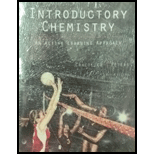
Interpretation:
The difference between a weak electrolyte and a nonelectrolyte is to be stated.
Concept introduction:
An electrolyte is a chemical substance that conducts electricity when dissolved in water. An electrolyte dissociated into its corresponding ions and distributes uniformly in the solvent. It is classified as a weak electrolyte and strong electrolyte.
Answer to Problem 1E
The difference between a weak electrolyte and a nonelectrolyte is given below.
• Weak electrolyte dissociates partially into their corresponding ions while nonelectrolyte does not dissociate into their corresponding ions in water.
• Weak electrolyte conducts a very small amount of electricity while nonelectrolyte does not conduct electricity.
Explanation of Solution
A weak electrolyte is a substance that does not dissociate completely into their corresponding ions when dissolved in water. A weak electrolyte produces a small amount of free ions in the solution due to which it conducts electricity. Weak acids, weak bases and insoluble salts are the example of weak electrolyte.
Nonelectrolyte is the substance that does not dissociate into their corresponding ions when dissolved in water. It does not produce free ions due to which it does not conduct electricity. Glucose is an example of a nonelectrolyte.
The difference between a weak electrolyte and a nonelectrolyte is given below.
• Weak electrolyte dissociates partially into their corresponding ions while nonelectrolyte does not dissociate into their corresponding ions in water.
• Weak electrolyte conducts a very small amount of electricity while nonelectrolyte does not conduct electricity.
Want to see more full solutions like this?
Chapter 9 Solutions
Bundle: Introductory Chemistry: An Active Learning Approach, 6th + LMS Integrated for OWLv2, 4 terms (24 months) Printed Access Card
- What is the difference between a solute and a solvent?arrow_forwardMolarity is a conversion factor relating moles of solute in solution to the volume of the solution. How does one use molarity as a conversion factor to convert from moles of solute to volume of solution, and from volume of solution to moles of solute present?arrow_forwardExplain why some electrolyte solutions are strongly conducting, whereas others are weakly conducting.arrow_forward
- The US Environmental Protection Agency (EPA) places limits on the quantities of toxic substances that may be discharged into the sewer system. Limits have been established for a variety of substances, including hexavalent chromium, which is limited to 0.50 mg/L. If an industry is discharging hexavalent chromium as potassium dichromate (K2Cr2O7), what is the maximum permissible molarity of that substance?arrow_forwardWhat is a spectator ion? Illustrate with a complete ionic reaction.arrow_forwardWhat is the final concentration of the solution produced when 225.5 mL of a 0.09988-M solution of Na2CO3 is allowed to evaporate until the solution volume is reduced to 45.00 mL?arrow_forward
- What volume of 0.0105-M HBr solution is required to titrate 125 mL of a 0.0100-M Ca(OH)2 solution? Ca(OH)2(aq)+2HBr(aq)CaBr2(aq)+2H2O(l)arrow_forward3.31 What is the difference between a total ionic equation and a net ionic equation?arrow_forwardDescribe the use of gravimetric analysis to determine the percentage of chlorine in a water-soluble unknown solid.arrow_forward
- A student weighs out a 4.80-g sample of aluminum bromide, transfers it to a 100-mL volumetric flask, adds enough water to dissolve it, and then adds water to the 100-mL mark. What is the molarity of aluminum bromide in the resulting solution?arrow_forwardWhich symbols are used to indicate solids, liquids, gases, and aqueous solutions in chemical equations?arrow_forward
 World of Chemistry, 3rd editionChemistryISBN:9781133109655Author:Steven S. Zumdahl, Susan L. Zumdahl, Donald J. DeCostePublisher:Brooks / Cole / Cengage Learning
World of Chemistry, 3rd editionChemistryISBN:9781133109655Author:Steven S. Zumdahl, Susan L. Zumdahl, Donald J. DeCostePublisher:Brooks / Cole / Cengage Learning General Chemistry - Standalone book (MindTap Cour...ChemistryISBN:9781305580343Author:Steven D. Gammon, Ebbing, Darrell Ebbing, Steven D., Darrell; Gammon, Darrell Ebbing; Steven D. Gammon, Darrell D.; Gammon, Ebbing; Steven D. Gammon; DarrellPublisher:Cengage Learning
General Chemistry - Standalone book (MindTap Cour...ChemistryISBN:9781305580343Author:Steven D. Gammon, Ebbing, Darrell Ebbing, Steven D., Darrell; Gammon, Darrell Ebbing; Steven D. Gammon, Darrell D.; Gammon, Ebbing; Steven D. Gammon; DarrellPublisher:Cengage Learning Chemistry for Engineering StudentsChemistryISBN:9781337398909Author:Lawrence S. Brown, Tom HolmePublisher:Cengage Learning
Chemistry for Engineering StudentsChemistryISBN:9781337398909Author:Lawrence S. Brown, Tom HolmePublisher:Cengage Learning- Chemistry: Matter and ChangeChemistryISBN:9780078746376Author:Dinah Zike, Laurel Dingrando, Nicholas Hainen, Cheryl WistromPublisher:Glencoe/McGraw-Hill School Pub Co
 Chemistry: Principles and PracticeChemistryISBN:9780534420123Author:Daniel L. Reger, Scott R. Goode, David W. Ball, Edward MercerPublisher:Cengage Learning
Chemistry: Principles and PracticeChemistryISBN:9780534420123Author:Daniel L. Reger, Scott R. Goode, David W. Ball, Edward MercerPublisher:Cengage Learning Introductory Chemistry: An Active Learning Approa...ChemistryISBN:9781305079250Author:Mark S. Cracolice, Ed PetersPublisher:Cengage Learning
Introductory Chemistry: An Active Learning Approa...ChemistryISBN:9781305079250Author:Mark S. Cracolice, Ed PetersPublisher:Cengage Learning





